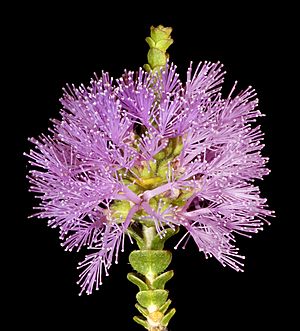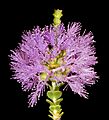Regelia ciliata facts for kids
Quick facts for kids Regelia ciliata |
|
|---|---|
 |
|
| Scientific classification | |
| Genus: |
Regelia
|
| Species: |
ciliata
|
| Synonyms | |
|
Melaleuca crossota Craven & R.D.Edwards |
|
Regelia ciliata is a type of plant that belongs to the myrtle family, called Myrtaceae. It grows only in the south-west part of Western Australia, which means it's endemic there. This plant is a tough, spreading bush with papery bark. It has small, wedge-shaped leaves and pretty purple flowers that grow in tight bunches during spring and summer.
Contents
What Does Regelia ciliata Look Like?
The Regelia ciliata is a strong, bushy plant that can grow to be about 1.3 to 1.5 meters (or 4 to 5 feet) tall. Its leaves are arranged in a special way: they grow in pairs, with each pair at a right angle to the one below it. This makes them look like they are in four neat rows along the stems.
The leaves are shaped like wide eggs, about 6 millimeters (0.24 inches) long and 4 millimeters (0.16 inches) wide. They have short hairs along their edges, which is why the plant's name includes "ciliata" (meaning "eyelash" in Latin).
Flowers and Fruit
The flowers of Regelia ciliata are a lovely mauve (light purple) color. They grow in dense, round clusters at the ends of the branches. These flower heads can be quite large, from 20 to 50 millimeters (0.8 to 2 inches) across. Even after the flowers bloom, the branches keep growing.
Each flower has 5 sepals (small leaf-like parts that protect the bud), 5 petals, and 5 groups of stamens (the parts that make pollen). This plant flowers for a long time during spring and summer. After the flowers fade, they turn into woody capsules. These capsules are small and grow in almost round clusters around the stem.
How Regelia ciliata Got Its Name
Regelia ciliata was the first plant in its group (genus Regelia) to be officially described by scientists. This happened in 1843. The description was written by a scientist named J.C.Schauer in a science journal called Linnaea.
The second part of its scientific name, ciliata, comes from the Latin word cilium. This word means "eyelash," and it refers to the short hairs that grow along the edges of the plant's leaves.
Where Regelia ciliata Grows
This plant is found in the Moore and Vasse River areas of Western Australia. It grows in sandy places that often get wet during the winter months. These areas are part of different natural zones, including the Avon Wheatbelt, Geraldton Sandplains, Jarrah Forest, and Swan Coastal Plain.
Regelia ciliata in Nature
Regelia ciliata has shallow roots and can handle soils that are very wet, even waterlogged. It grows on a place called the Gnangara Mound, which is an important underground water source. However, water is being taken from this mound to supply the city of Perth. When the water levels drop, the number of Regelia ciliata plants in these areas can also go down. Other plants like Astartea fascicularis, Hypocalymma angustifolium, and Pericalymma ellipticum are also affected in a similar way.
Conservation Status
The good news is that the Western Australian government's department of parks and wildlife currently says that Regelia ciliata is "not threatened." This means it's not in danger of disappearing right now.
Growing Regelia ciliata in Gardens
Regelia ciliata is a tough plant, especially compared to other plants in its group. It has been grown successfully in gardens in eastern Australia. You can grow new plants from seeds, which are released from the fruit a few days after you pick them. You can also grow new plants from cuttings taken in autumn.
This plant can grow well in full sun or in partial shade. It also likes it when you trim it once a year and add some plant food (fertilizer).
Images for kids


